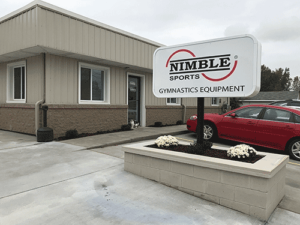By Mike Hall
Exercising your calf and lower leg muscles is extremely important for maintaining gymnastics health and preventing injuries. The common ankle sprains and rolled ankle injuries, and many knee injuries can be attributed to not enough muscle training and strengthening of lower leg muscles – particularly in the calf. We’ve listed a few great exercises to strengthen those muscles that are best performed after a workout.
Strength
Heel to Toe Walking
Walk across a soft surface barefoot while balancing only on your heels. Feel free to walk on a straight path, or make it fun by maneuvering obstacles. and then for another minute, walk only on your toes. You can switch things up and target new muscles by pointing your heels or toes straight, inside or outside. If done correctly, you won’t need to do this exercise for longer than a minute.
Towel Scrunches

Although this exercise does not specifically strengthen your two main muscles in your calves, it helps improve balance, allowing you to engage your calf muscles more during exercises and routines. With one foot barefoot, place a towel on a smooth floor surface and place your foot on top of the towel. Grab the towel with your toes, like you would if your foot was a hand, and then release to make the towel flat again. Repeat this ten times with each foot. To add resistance, make the towel wet, or place a small dumbbell at the end of the towel.
Calf Raises
You can stand on the edge of a balance beam or on a mat with your heels over the edge and your toes pointing straight forward. Quickly raise onto your toes, hold for one second, and then gradually lower them back down. Try and keep your feet close together and not let them drift apart. You can do variations of this by pointing your heels together with your toes apart and pointing your heels apart and toes together. This targets different muscle groups in your calves.
Cross Jumps
Balance on one leg on just your toes, and then jump forward-backward-left-right. Repeat this movement for 30 seconds and then immediately switch to the other leg. To increase difficulty, you can make the distance between the jumps larger. You can also introduce a jump rope to the movement to ensure you are jumping high enough.
Flexibility
Because calf flexibility is just as important as calf strength, we’ve included stretches to improve the flexibility of your calves for gymnastics.
Towel Stretch
Grab a towel and take your shoes off if you have any on. Sit with your legs facing straight, and wrap the towel around the ball of one foot. With your legs and arms straight, pull on the towel by leaning back with your back straight and chest up. When you start feeling resistance, just hold and breathe for 15-30 seconds. Switch legs and repeat.
Runners Stretch
Extend your arms and place them on a wall with your back straight. Put one leg behind the other with the heel flat on the floor and do not bend at the knee. The other leg that is in front should be in a lunge position. Stretch by collapsing your elbows and lunging closer to the wall with your back leg’s heel still remaining on the ground. If this stretch isn’t enough for you, go into a deeper lunge, and really focus on keeping your back leg straight.
Downward Dog

This move is often used in yoga, and helps stretch major muscle groups in your calves. Start in an upward plank position, or the position with your arms extended that you would have before doing a pushup. Stick your behind up in the air and push your chest towards your toes. Don’t move the position of either your hands or your feet. If you’ve become really flexible and can keep your heels on the floor, you can start trying to raise your toes in the air to get more out of the stretch.
Dynamic Downward Dog
This stretch is very similar to the one above, but involves a lot more movement, which makes it ideal as the first calf stretch you do, and for right before you start a gymnastics routine. While in the downward dog position, lift one leg off the ground and extend it as high behind you with the knee straight. Swing the leg up to your chest while rocking your whole body forward slightly. This stretch also helps warm up your muscles in your arms and your core. After 10-15 reps, switch legs.
A Few Important Tips
- It will take your calf muscles a while to strengthen and become more flexible. Only do what you feel comfortable doing, and if something doesn’t feel right, stop!
- Only perform calf exercises after your gymnastics practice. If you fatigue them before you practice, your balance and posture will off, you won’t be able to engage your core leg muscles to their full potential, and you will be at a higher risk of injury during your practice.
- If anything is sore or stiff after a workout, be sure to ice the areas. Once you start icing though, you are shutting your muscles down for the day. Don’t do any more exercises or stretching.

